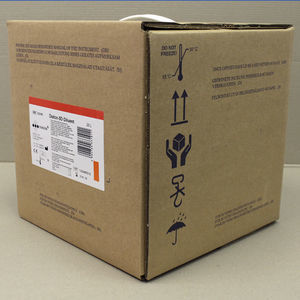

- Products
- Catalogs
- News & Trends
- Exhibitions
Solution reagent 20313Pfor cell countingdiagnosticblood sample
Add to favorites
Compare this product
Characteristics
- Type
- solution
- Applications
- for cell counting, diagnostic, blood sample, for hematology
- Tested parameter
- hemoglobin
Description
Dialyse-Baso II is used by the ABX Pentra 60, 80, Coulter AcT 5Diff hematological analyzer red blood cell hemolysing reagent for the assay of basophil cell count.
SUMMARY AND PRINCIPLE
A sample volume of a whole blood specimen is aspirated into the analyzer where a portion of it is automatically diluted with Diadifton Argos/Pentra. A portion of this first dilution is further diluted with Diadifton Argos/Pentra. This second dilution of the sample is then introduced into impedance particle analyzer where the red blood cell count (RBC) and the thrombocyte count (PLT) is measured. To the remainder of the first dilution of the RBC sample a hemoglobin lyse reagent (Dialyse-Argos Pentra) is added for hemoglobin (HGB) measurement. A second portion of the aspirated blood sample is also diluted with lyse reagent (Diafix EO5 Diff. P60) and diluent is added at the end of the reaction as a stop reagent. From this aliquot the flow cytometer measures white blood cell count (WBC), lymphocyte count (LYM), monocyte cell count (MONO), eosinophil cell count (EO), neutrophil cell count (NEU). A third portion of the aspirated blood sample is lysed with a lysing reagent (Dialyse-Baso II) for basophil cell count (BASO) measurement in an impedance detector.
Catalogs
No catalogs are available for this product.
See all of Diagon Ltd.‘s catalogsExhibitions
Meet this supplier at the following exhibition(s):

Related Searches
- Solution reagent kit
- Protein reagent kit
- Diagnostic reagent kit
- Laboratory reagent kit
- Enzyme reagent kit
- Reagent medium reagent kit
- Cytology reagent kit
- Dye reagent
- Blood sample reagent kit
- Staining solution reagent kit
- POC reader
- Enzymatic reagent kit
- Hematology reagent kit
- Blood POC reader
- POC reader with touchscreen
- Portable POC reader
- Whole blood POC reader
- Hemoglobin reagent kit
- Laboratory POC reader
- Cleaning reagent kit
*Prices are pre-tax. They exclude delivery charges and customs duties and do not include additional charges for installation or activation options. Prices are indicative only and may vary by country, with changes to the cost of raw materials and exchange rates.






























